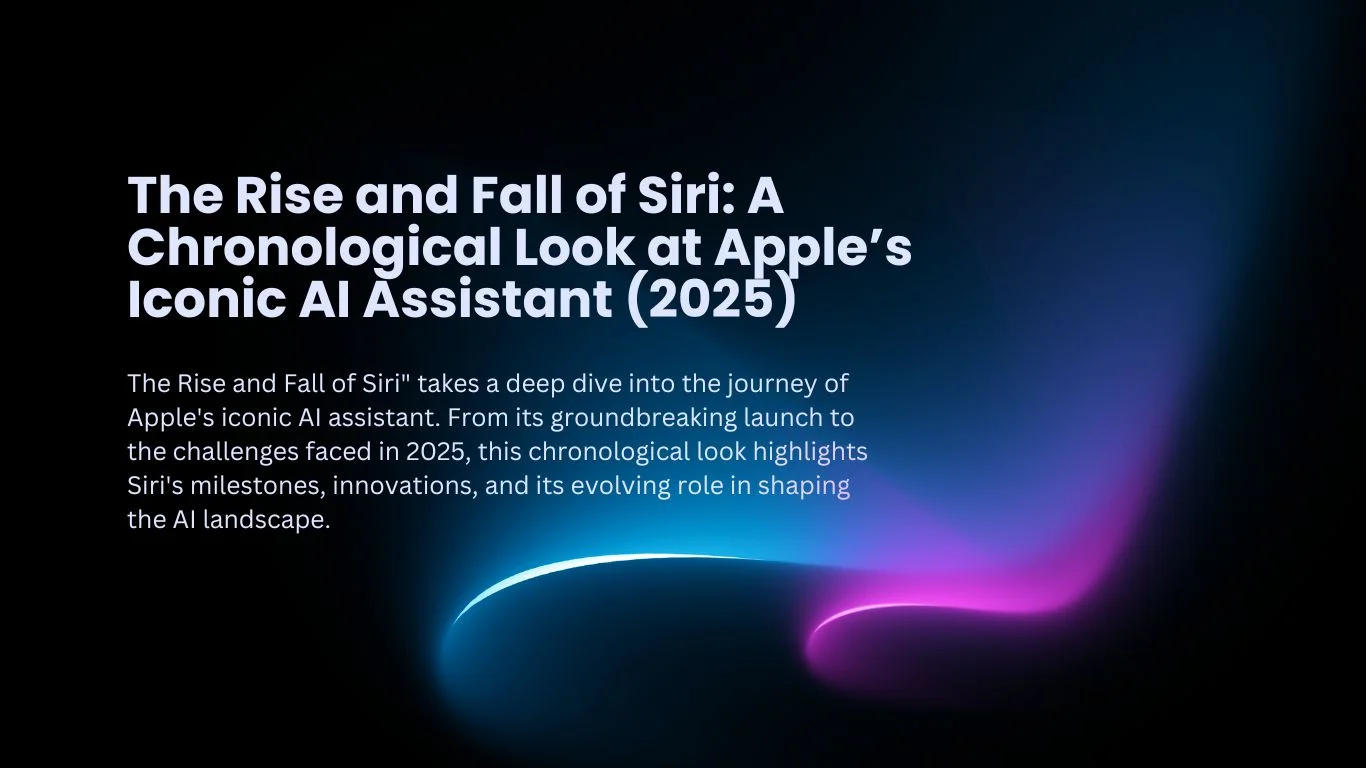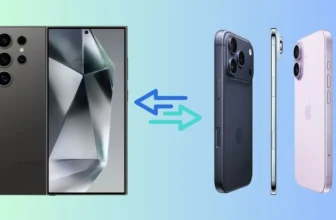
Siri, Apple’s voice-activated AI assistant, revolutionized the way we interact with smartphones and digital devices. From its groundbreaking introduction in 2011 to its status as a cultural icon, Siri played a pivotal role in shaping the future of artificial intelligence and voice assistants. However, despite its early success, Siri’s journey has been far from linear. As of 2025, Siri finds itself in a complex position—still widely used but facing increasing competition and criticism. This article takes a chronological look at Siri’s rise, its peak, and its subsequent challenges, exploring how Apple’s iconic AI assistant evolved over time.
The Rise of Siri: The Beginning of a Revolution (2011–2013)
2011: Siri’s Grand Introduction
The journey of Siri began in 2011 when Apple acquired the voice recognition startup Siri, founded by Dag Kittlaus, Tom Gruber, and Adam Cheyer. It wasn’t long before Apple integrated Siri into its iPhone 4S, marking the first time voice recognition was made available at such a scale. Siri was introduced as a groundbreaking feature, allowing users to interact with their iPhones using natural language—asking it questions, setting reminders, or dictating messages.
Siri immediately stood out in the crowded smartphone market, offering voice-activated assistance in a way that felt intuitive and personal. At launch, the voice assistant was celebrated for its innovative approach and felt like a glimpse into the future of mobile technology.
2012–2013: The Early Hype and Market Domination
In the years following Siri’s debut, the feature became synonymous with the iPhone. It wasn’t just a convenient tool; it was a cultural phenomenon. With features like the ability to tell jokes, answer trivia, and perform basic tasks, Siri provided users with a sense of companionship and intelligence. Apple’s continued integration of Siri into products like the iPad, Apple TV, and the Apple Watch further solidified its presence in the digital ecosystem.
Siri’s early days were marked by excitement, with the voice assistant seen as a glimpse into the future of AI and human-computer interaction. Apple’s marketing campaigns emphasized Siri’s uniqueness, setting it apart from other voice assistants on the market.
You May Know About: How to Block Spam Calls on Android and iPhone?
The Peak of Siri: A Dominant Force in AI (2014–2017)
2014: Expanding Siri’s Capabilities
By 2014, Siri had grown more powerful. Apple began integrating it with deeper functionality within the iOS ecosystem, allowing users to set reminders, send texts, make phone calls, and even control smart home devices using voice commands. Siri was no longer just a novelty; it was becoming a truly useful assistant.
One of the key milestones during this period was the introduction of “Hey Siri” in iOS 8 (2014). The ability to activate Siri hands-free was a game-changer, providing users with a new level of convenience and making Siri feel even more indispensable.
2015–2017: Siri Becomes a Staple of Apple Devices
Throughout these years, Siri became deeply ingrained in Apple’s ecosystem. Its integration into the Apple Watch in 2015 brought voice assistance to wearables, and by 2017, Siri was available on virtually all Apple devices. Siri’s functionality continued to expand, including more robust integration with third-party apps and services.
In addition, Apple introduced SiriKit, which allowed developers to create apps that could work seamlessly with Siri, expanding its capabilities beyond Apple’s native apps. This era also saw the introduction of Siri’s voice recognition abilities, which enabled it to understand and respond to individual users, offering a more personalized experience.
For a time, Siri seemed unstoppable, and the competition, including Google Assistant and Amazon’s Alexa, was still catching up.
The Fall of Siri: Challenges and Declining Innovation (2018–2025)
2018–2020: The Beginning of Decline
By 2018, Siri’s prominence started to wane. While it was still widely used, other voice assistants such as Google Assistant and Amazon Alexa began to emerge as more powerful alternatives, often outperforming Siri in key areas like accuracy, speed, and natural language understanding.
Apple’s slow pace of innovation and focus on privacy led to Siri’s stagnation. While the company emphasized protecting user data, Siri’s ability to perform tasks and understand complex queries seemed limited compared to its competitors. Google’s AI, powered by vast amounts of data, provided quicker, more accurate answers, and Amazon’s Alexa became synonymous with smart home devices, offering unparalleled integration with third-party gadgets.
During this period, Apple’s efforts to catch up with features like multi-language support and improved natural language processing didn’t seem to fully address the growing gap between Siri and its rivals. Siri started to feel more like a secondary feature rather than a cutting-edge innovation.
2021–2023: Siri Faces Increasing Criticism
By 2021, the tide had turned. Critics began to point out Siri’s limitations, with many claiming that the voice assistant was falling behind the times. Siri’s responses were often seen as too generic or lacking in depth, especially when compared to the highly personalized, context-aware responses offered by Google Assistant.
Additionally, the growing popularity of Amazon’s Alexa, which had integrated deeply into smart homes with thousands of compatible devices, put Siri at a distinct disadvantage. Users looking for seamless smart home integration found that Apple’s offerings were less expansive than those of Amazon or Google.
2024–2025: Siri’s Current State
As of 2025, Siri has become a tool that many still use but is no longer the dominant force it once was. Apple has continued to enhance Siri’s privacy features, but it now faces an uphill battle against far more sophisticated AI assistants like Google Assistant, which benefits from vast search data, and Amazon’s Alexa, which remains the go-to for smart home management.
Siri’s lack of progress in key areas such as multi-device synchronization and artificial intelligence has led many to abandon it in favor of Google and Amazon’s solutions. While Siri remains integrated into Apple products like the iPhone, iPad, Mac, and Apple TV, its role is more limited. Apple now emphasizes privacy and security more than innovation, with Siri’s abilities often taking a backseat to the company’s overall product strategy.
Why Siri Fell Behind: Key Reasons
- Innovation Stagnation: Siri’s early years were marked by rapid growth and innovation, but Apple’s slow pace of improvement in key areas, such as natural language processing and AI-powered predictions, led to its decline.
- Privacy vs. Data-Driven AI: Apple’s commitment to user privacy, while commendable, limited Siri’s ability to access the vast data needed to improve its intelligence. In contrast, Google and Amazon have leveraged user data to fine-tune their voice assistants.
- Competition from Alexa and Google Assistant: Alexa and Google Assistant excelled in smart home integration and AI-powered search, areas where Siri fell behind.
- Lack of Ecosystem Growth: Siri’s limited third-party app support and lack of deeper integration with the growing smart home market hampered its effectiveness compared to Alexa.
Read More: How to Replace a Cracked Screen
The Future of Siri: Can Apple Recover?
While Siri may not hold the same prominence it once did, Apple has not completely abandoned it. The company continues to invest in enhancing Siri’s capabilities, particularly with a focus on privacy, security, and integration with Apple’s own ecosystem.
However, for Siri to make a comeback, Apple will need to significantly improve its AI and voice recognition capabilities, as well as develop new, innovative features that set it apart from its competitors. In 2025, Siri is far from irrelevant, but it’s no longer the revolutionary force it once was.
Conclusion
Siri’s journey from an innovative breakthrough to a digital assistant that has struggled to keep up with competition highlights both the challenges and opportunities in the world of AI. Apple’s decision to prioritize privacy over data-driven AI advancements, combined with stiff competition, has limited Siri’s growth. While it’s unlikely that Siri will ever return to its peak status, its legacy remains as a pioneer in voice-activated AI assistants.
The future of Siri lies in how Apple chooses to evolve it in the coming years. If the company can adapt to the growing demands for smarter, more personalized AI assistants while maintaining its commitment to privacy, Siri could yet find a way to regain relevance in the ever-competitive AI assistant landscape.
Frequently Ask Questions (FAQ’s):
Siri is Apple’s voice-activated AI assistant, introduced in 2011. Apple acquired the startup Siri and integrated it into the iPhone 4S, allowing users to interact with their devices using natural language. Siri became one of the first mainstream voice assistants, revolutionizing the way users interacted with their smartphones.
– 2011: Siri was introduced as a groundbreaking feature in the iPhone 4S.
– 2014: The “Hey Siri” feature was introduced, allowing hands-free voice activation.
– 2015–2017: Siri was integrated into various Apple devices, including the Apple Watch, and developers were given the opportunity to integrate Siri with third-party apps through SiriKit.
Siri became synonymous with Apple’s ecosystem, gaining widespread popularity during these years.
Siri became popular because it was the first widely accessible AI assistant that allowed users to interact with their phones in a conversational manner. With capabilities like sending texts, setting reminders, and answering trivia questions, Siri created an engaging, futuristic experience. Its integration with Apple’s ecosystem and its inclusion in the iPhone made it a central feature of Apple’s product offerings.
By 2018, Siri began facing challenges from its competitors. Google Assistant and Amazon Alexa started to outperform Siri in terms of speed, accuracy, and natural language understanding. Siri’s lack of rapid innovation, along with its limitations in third-party integrations and complex queries, began to impact its dominance.
Several factors contributed to Siri’s decline:
Slow innovation: While competitors like Google and Amazon rapidly improved their voice assistants, Siri’s features stagnated.
Privacy vs. data: Apple’s focus on privacy limited Siri’s ability to gather the vast amounts of data necessary for improving its AI.
Competitor advancements: Google Assistant and Alexa were able to offer better integration with third-party apps, faster responses, and more personalized experiences.
– Google Assistant: Leveraged Google’s search capabilities to provide more accurate, context-driven answers. It also excelled in understanding natural language.
– Amazon Alexa: Focused on smart home integration, becoming the go-to assistant for controlling smart devices, offering greater ecosystem compatibility.
– Siri: While Siri offered strong integration with Apple devices, it lagged in terms of natural language understanding, third-party integrations, and smart home management.
This FAQ provides a comprehensive overview of Siri’s journey, from its rise as a revolutionary technology to its decline amid competition. While Siri may not have maintained the same dominance it once had, it remains an important part of Apple’s ecosystem, and the future could hold new opportunities for revitalizing the service.





